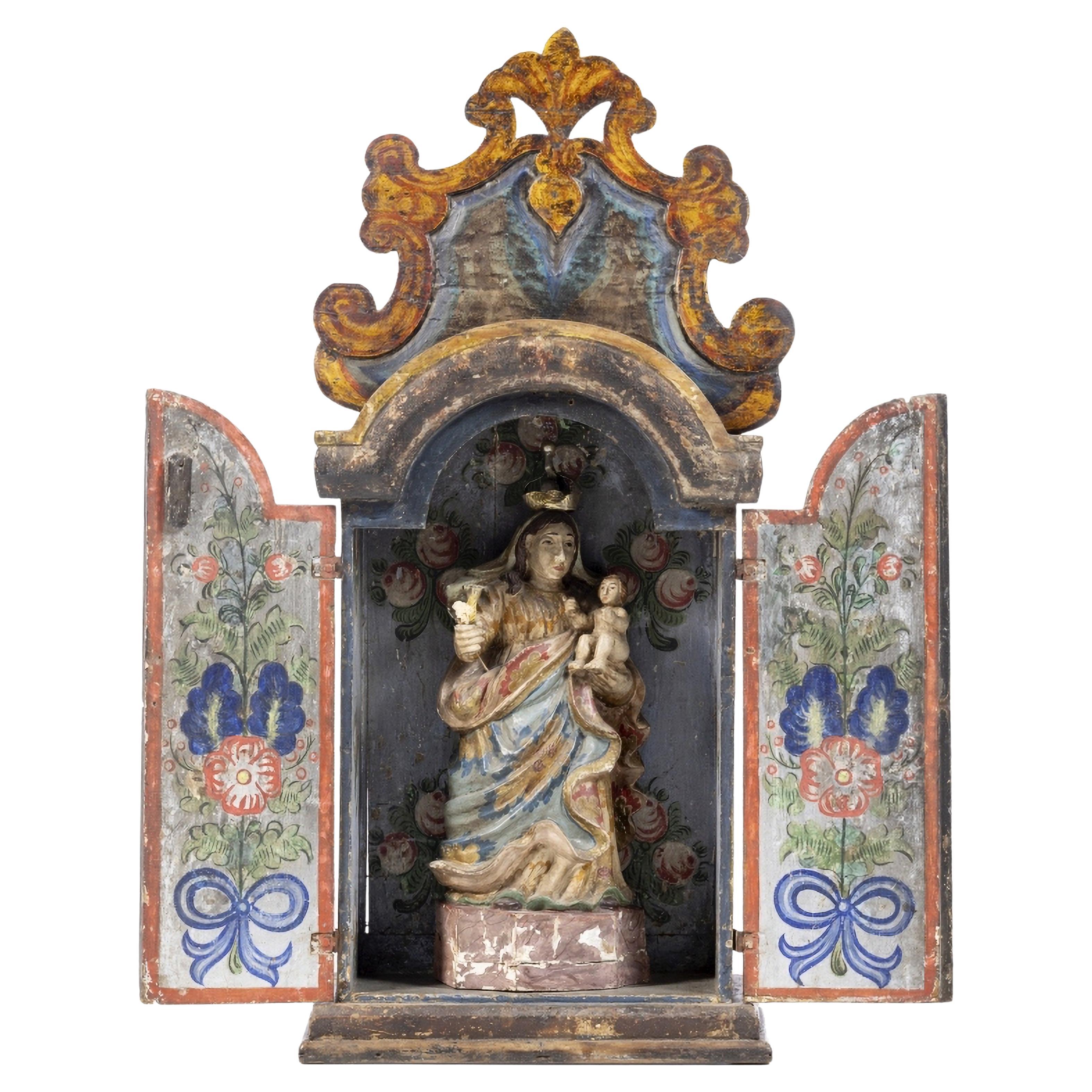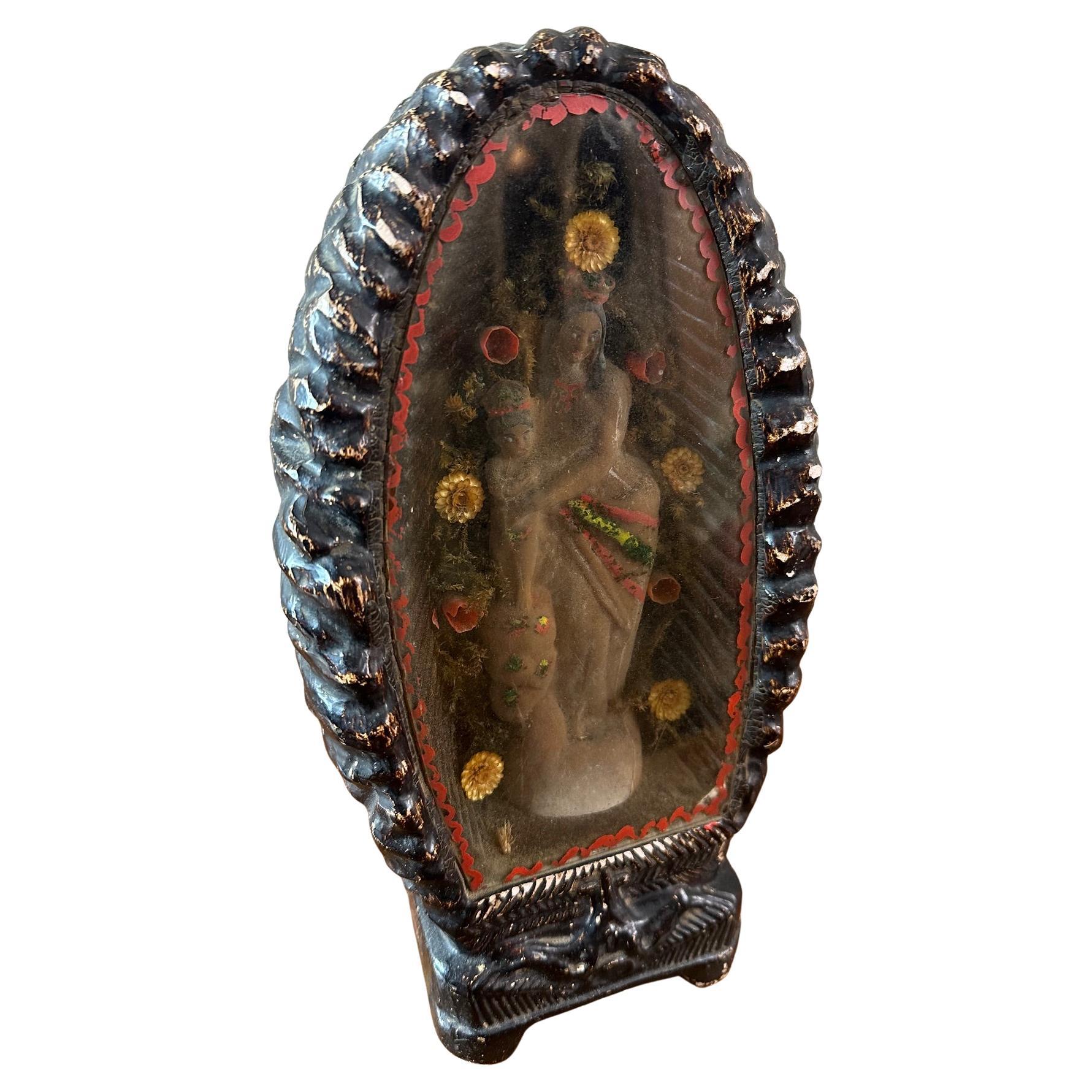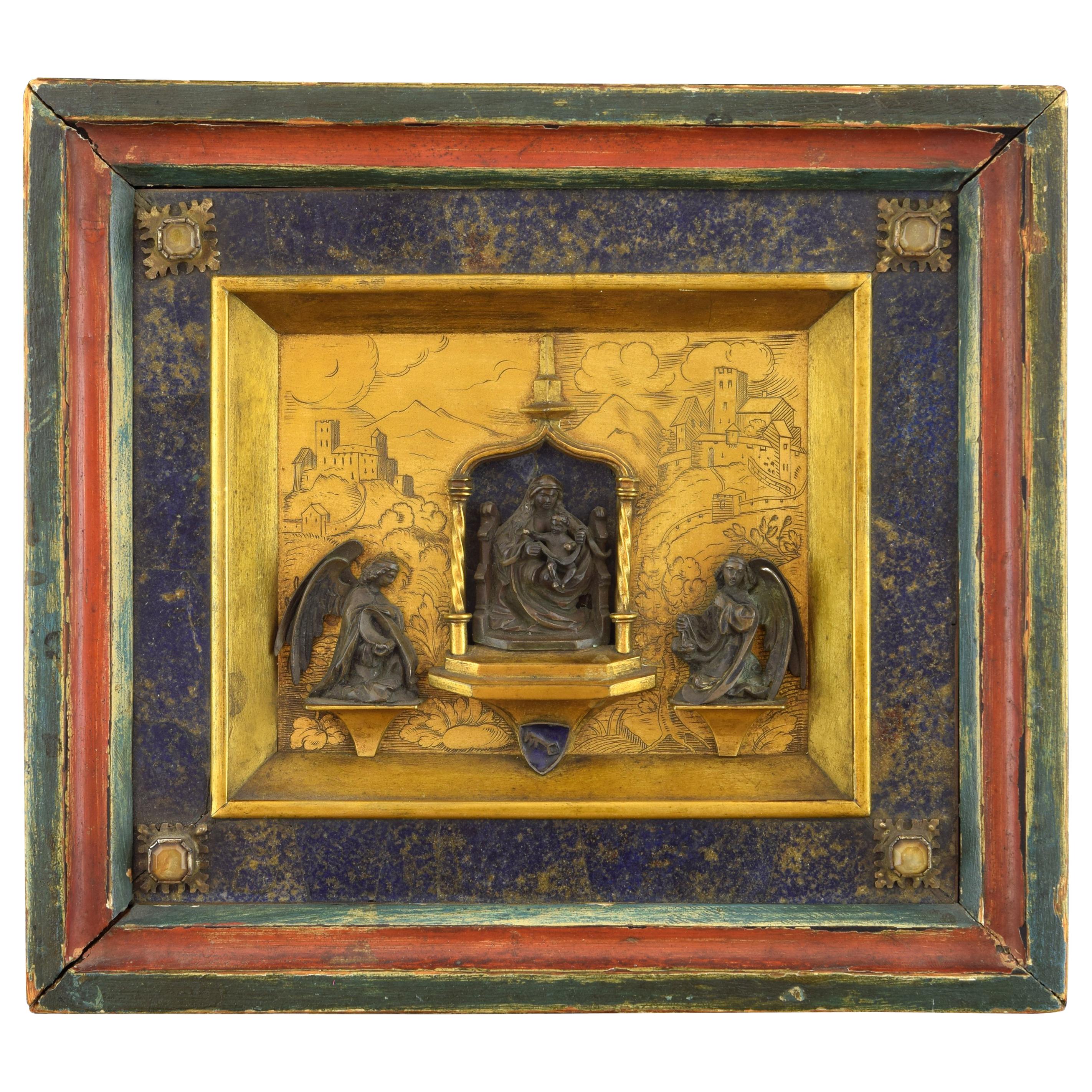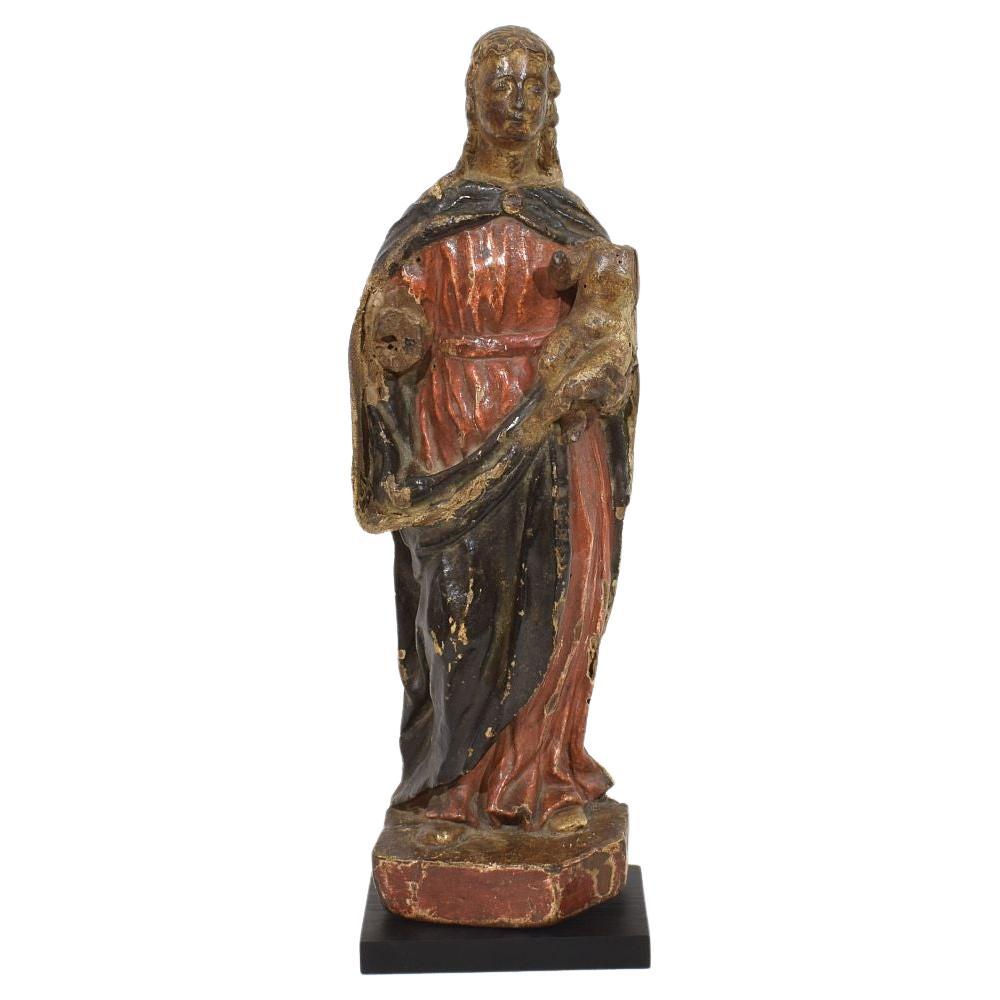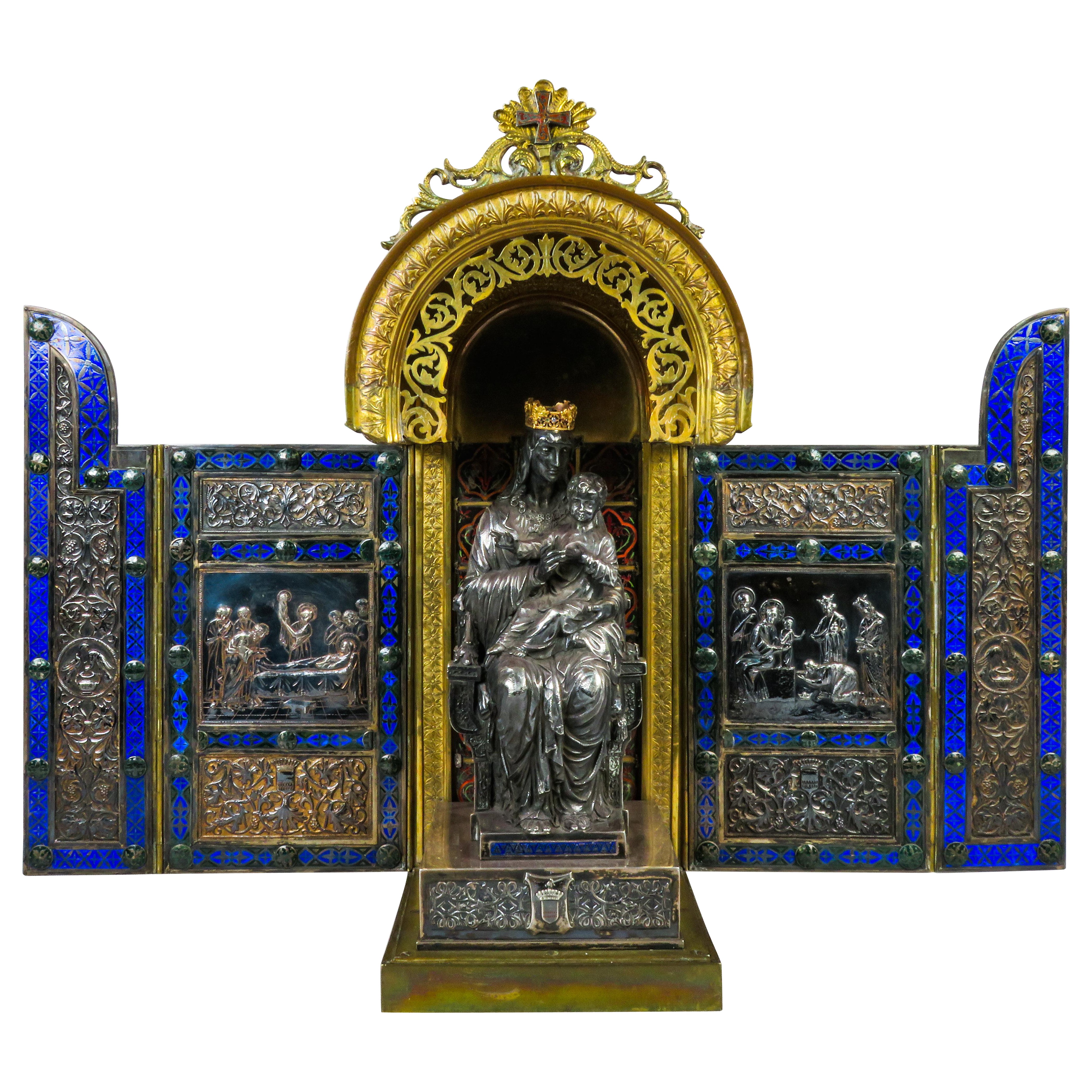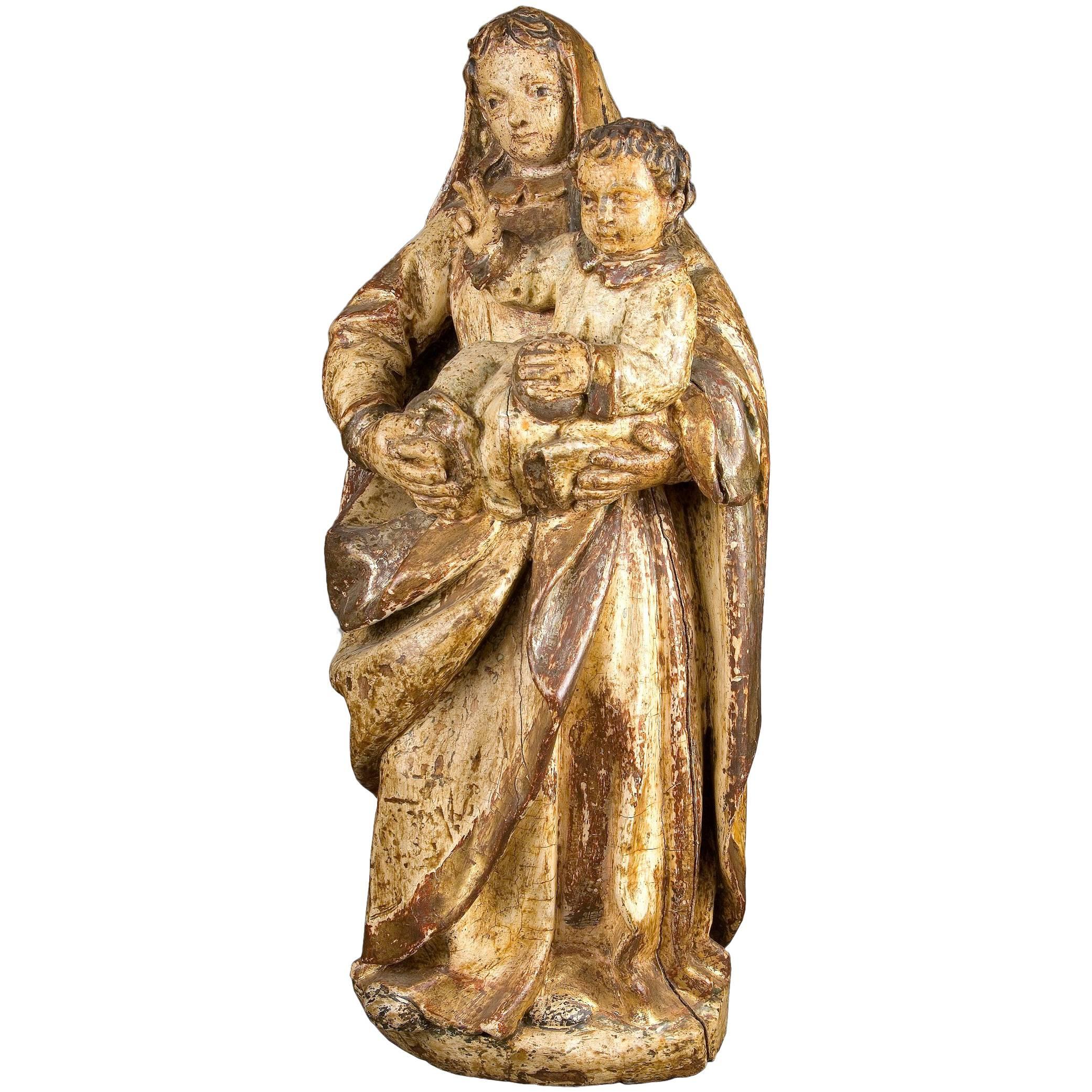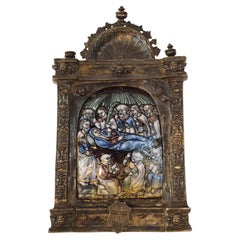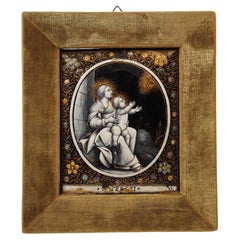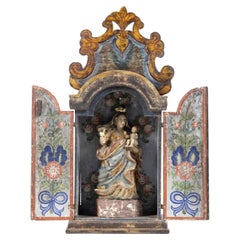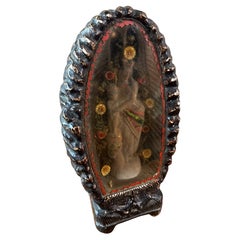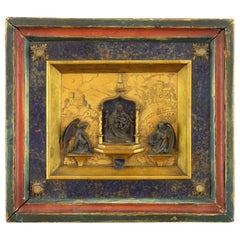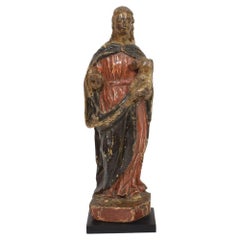Items Similar to Miniature Altar with Mother Mary with infant Jezus in Renaissance style, 1657
Want more images or videos?
Request additional images or videos from the seller
1 of 16
Miniature Altar with Mother Mary with infant Jezus in Renaissance style, 1657
$1,430.24
£1,059.09
€1,200
CA$1,966.80
A$2,187.59
CHF 1,144.94
MX$26,681.35
NOK 14,386.54
SEK 13,532.40
DKK 9,135.97
About the Item
Wooden miniature altar with Mother Mary with infant Jezus in Renaissance style.
This altar - used for private devotion - was made in the 17th century and is dated on the base 1657.
Several elements such as the pillars at each side of Mother and child, the square basements of the pillars, the top ormanent in the form of a trapesium, and the 'wings' at the sides are a reflection of the renaissance style-period.
The small statue of Mary and the infant Jezus presumably has the original polychromy.
The frame around the statue with a pattern of flowers used to have a golden appearance, but the leather is browned due to aging. The outer frame is decorated with stars.
The upper top ornament and several rosettes are missing, red velvet background renewed.
This altar is made in Flanders or Germany.
ca. 32 x 22 x 10 cm
- Dimensions:Height: 9.06 in (23 cm)Width: 8.67 in (22 cm)Depth: 3.94 in (10 cm)
- Style:Renaissance (Of the Period)
- Materials and Techniques:
- Period:
- Date of Manufacture:1657
- Condition:Replacements made: Red velvet background renewed. Wear consistent with age and use. Minor losses.
- Seller Location:Gorssel, NL
- Reference Number:1stDibs: LU8869242507832
About the Seller
5.0
Vetted Professional Seller
Every seller passes strict standards for authenticity and reliability
1stDibs seller since 2023
- ShippingRetrieving quote...Shipping from: Gorssel, Netherlands
- Return Policy
Authenticity Guarantee
In the unlikely event there’s an issue with an item’s authenticity, contact us within 1 year for a full refund. DetailsMoney-Back Guarantee
If your item is not as described, is damaged in transit, or does not arrive, contact us within 7 days for a full refund. Details24-Hour Cancellation
You have a 24-hour grace period in which to reconsider your purchase, with no questions asked.Vetted Professional Sellers
Our world-class sellers must adhere to strict standards for service and quality, maintaining the integrity of our listings.Price-Match Guarantee
If you find that a seller listed the same item for a lower price elsewhere, we’ll match it.Trusted Global Delivery
Our best-in-class carrier network provides specialized shipping options worldwide, including custom delivery.More From This Seller
View AllAntique icon Jaroslav depicting the Mother of God of Life spending well, 17th c.
Located in Gorssel, GE
Monumental icon depicting the Mother of God of Life spending well (Zoodochos Pege).
Jaroslav, late 17th century.
Dimensions: 80 x 60 cm.
Category
Antique 17th Century Russian Religious Items
Materials
Wood
Limoges enamel plaque the Assumption of Mary, silver frame. France, around 1600
Located in Gorssel, GE
Limoges enamel pax depicting the Assumption of Mary, in a silver frame in Renaissance style decorated with scrollwork and five angel heads,
ca. 1600.
Total height: 14.8 cm., width...
Category
Antique Early 1600s French Religious Items
Materials
Copper, Enamel, Silver
Religious icon depicting the Mother of God Kasperovskaja, 19th century
Located in Gorssel, GE
Russian icon from an old-believersworkshop depicting the Mother of God Kasperovskaja, a variation of the Mother of God of Korsun.
19th century.
Dimension: 31 x 26.5 cm.
In good c...
Category
Antique 19th Century Russian Religious Items
Materials
Wood
Enamel plaque Madonna with Child Materdei, Jean Laudin, France, 17th c.
Located in Gorssel, GE
A rectangular enamel plaque "Madonna with Child and radiant cross" inscription "Materdei".
Signed I.L. (Jean LAUDIN)
Monogrammed at the bottom right and on the back inscription Laudi...
Category
Antique 17th Century French Religious Items
Materials
Enamel, Copper
Antique icon depicting the Mother of God of the Sign, ca. 1800
Located in Gorssel, GE
Meditative Central Russian icon depicting the Mother of God of the Sign, also titled the Znamenje of Novogrod. Typical for this centuries old iconography is that the Mother of God is...
Category
Antique Early 19th Century Russian Religious Items
Materials
Wood
Wooden casket with polychrome and gilded "pastiglia" relief decor, Italy 15th c.
Located in Gorssel, GE
A rare wooden casket with polychrome and gilded pastiglia relief, Italy, 15th century.
The box is adorned with four finely executed scenes from the life of an unknown martyr — beautifully preserved and remarkably vivid after centuries.
Dimensions: 15.5 × 10.4 × 9 cm
Provenance: Dutch private collection
In overall good condition for its age, with minor losses to the surface and possible retouching to the polychromy. The ball feet are likely later additions.
Pastiglia [paˈstiʎʎa], an Italian term meaning "pastework", is low relief decoration, normally modelled in gesso or white lead, applied to build up a surface that may then be gilded or painted, or left plain. The technique was used in a variety of ways in Italy during the Renaissance.
White lead pastiglia was a north Italian speciality, produced between about 1450 and 1550. Six workshops were identified by Patrick M. De Winter, although their location remains uncertain; the Workshop of the Love and Moral Themes, whose products seem the most numerous, was possibly at Ferrara, where the painter Cosimo Tura began his career gilding caskets. Venice is also thought to have produced them. Other workshops identified by De Winter include the "Workshop of the main Berlin casket" and "Workshop of the Cleveland Casket".
The subjects were typically classical, drawn from both mythology and Ancient Roman history (especially the early period covered by Livy), but biblical ones are also found. Compositions can often be shown to be borrowed from another medium, such as prints or bronze plaquettes...
Category
Antique 15th Century and Earlier Italian Renaissance Decorative Boxes
Materials
Gesso, Wood
You May Also Like
"OUR LADY OF GLORY WITH ORATORY" Brazilian sculpture of the 19th century
Located in Madrid, ES
OUR LADY OF GLORY WITH ORATORY
Brazilian sculpture of the 19th century
, in polychrome and gilded wood.
Oratory in painted and gilded wood.
Small defects.
Dim.: (sculpture) 42 cm;
(...
Category
Antique 19th Century Brazilian Baroque Religious Items
Materials
Wood
$8,104 Sale Price
20% Off
19th century French Reliquary Virgin and the Child, 1890s
Located in LEGNY, FR
Beautiful 19th century reliquary representing a virgin and child surrounded by flowers and framed in a glazed terracotta frame. Glass decorated with hand-painted decoration. Good qua...
Category
Antique Late 19th Century French Religious Items
Materials
Terracotta, Glass
"Madonna with Child and Angels". Italy, 15th-16th Centuries
Located in Madrid, ES
Bronze in its color and gold, lapis lazuli, rock crystal, enamel.
In the centre of the work is presented, enthroned, the figure of Mary, with a mantel (fireplace) on her shoulders and hair and holding on her knees the child, who appears addressing one of the angels. The virgin is also sheltered by an ogee arch supported on turned columns, and raised visually by steps. This composition achieves a very striking contrast: the dark bronze figure, in contrast to the lapis lazuli background and the part of the arch and the outside of it, in gilded bronze. Under the steps there is a heraldic enamel shield with a key on an azure background. The angels, kneeling, are flanking this figure, and, appearing in dark bronze, visually share the "category" of religious figures with Mary, while their (lower) position gives more status to both the Mother and Jesus. The rest of the composition is completed with a delicate landscape: constructions and walls on mountains, clouds in the sky, plants, stones, etc. To the outside, another lapis lazuli frame is placed decorated in the corners with appliques, giving way to carved and polychrome wood. The lapis lazuli is a semiprecious stone already known in the seventh millennium BC., found in deposits from the Caucasus to Mauritania. From the end of the middle ages, it increased its export to Europe, its use being more frequent since then both to use it as a pigment in paintings after grinding it (giving rise to the finest and most expensive of the blues, and of the colors in many occasions), as for backgrounds of paintings, incrustations in works of art, jewelry and, a little later, in the well-known "hard stone works". The figure of Mary still shows an influence of Gothic models, although more European than Italian, along with elements that could already show a closeness to the Renaissance: although the nakedness of Jesus is already shown in Gothic works (Madonna with Angels by Fra Angelico ), the creation of space by playing with the cloth in front of Christ can be appreciated in more advanced paintings (Virgin with Child by Domenico Ghirlandaio, National Gallery of London); the presence of a powerful throne can be seen frequently in Italian Madonnas of the Quattrocento (and before), but not quite as presented here. As for the landscape, it is necessary to compare it, for example, with that of the fresco of the Condotiero Guidoriccio de Fogliano (Simone Martini, finished in 1328). This is a work of great technical and aesthetic quality, not to mention the materials chosen for its creation, comparable only to outstanding examples from around the world, such as those preserved in the Palazzo Madama in Torino (Italy), where the coral It also has an important role. It is essential to mention, also, works such as the plate of hard stones (lapis lazuli between them) with a relief of Mary with the Child in...
Category
Antique 16th Century Italian Renaissance Religious Items
Materials
Lapis Lazuli, Bronze, Enamel, Other
French 17th Century Baroque Wooden Madonna with Child
Located in Buisson, FR
Lovely hand carved wooden Madonna with child with traces of old color. Despite of the fact this piece has several losses , she has a wonderful and strong expression and beautiful old...
Category
Antique 17th Century French Religious Items
Materials
Wood
$947 Sale Price
45% Off
Triptych niche with a sculpture of Virgin Mary with Child Jesus
Located in Madrid, España
Triptych niche with a sculpture of the crowned Virgin Mary with the enthroned Child Jesus located in the center, flanked by scenes from the life of the Virgin Mary on the doors. Gilt...
Category
Vintage 1920s Spanish Figurative Sculptures
Materials
Sterling Silver, Bronze
"Virgin with Child Jesus". Spain, End of the 17th-Early 18th Century
Located in Madrid, ES
Spanish Baroque sculpture is one of the most authentic and personal examples of our art, because its conception and its form of expression arose from the people and from the deepest ...
Category
Antique Late 17th Century Spanish Baroque Religious Items
Materials
Wood
More Ways To Browse
Renaissance Style Frame
German Renaissance
Small Pillars
Antique Wood Pillars
Small Altar
Altar Flowers
Altar Frame
Antique Wooden Rosettes
German Renaissance Wood Furniture
Antique Wooden Pillar
Mary Statue
Miniature Altar
Mother Mary Statue
Mid Century Plastic Furniture
Switzerland Furniture
Small Collectables
1960 Rug Wool
Antique Glass Plates
